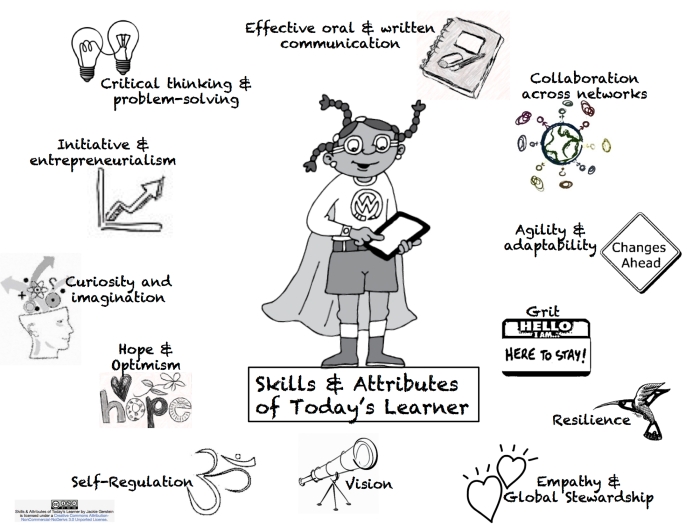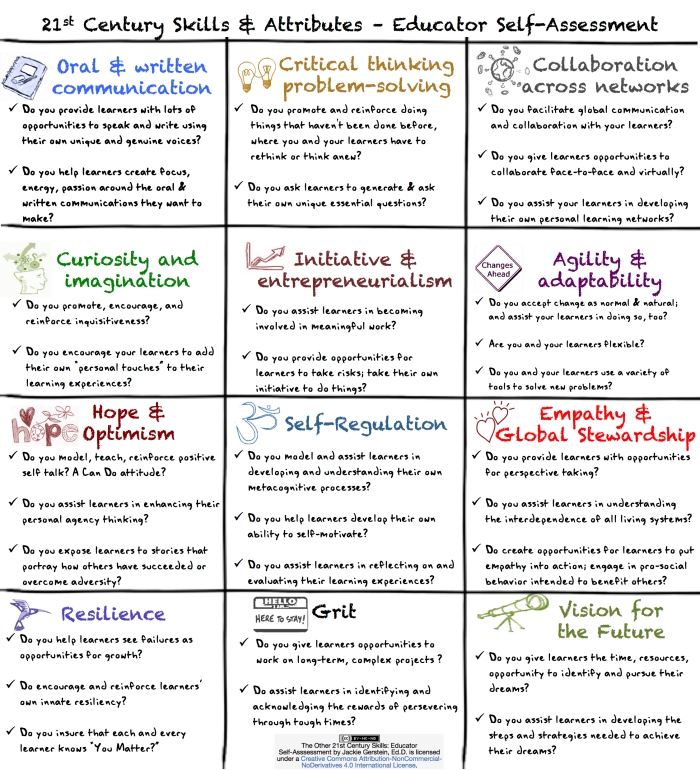The Other 21st Century Skills: Educator Self-Assessment
I’ve posted about The Other 21st Skills and Attributes. This post provides links and resources about these skills as well as an educator self-assessment. This assessment contains questions to assist the educator in evaluating if and how s/he is facilitating these skills and attributes in the learning environment. 
Related Resources:
- The Other 21st Century Skills: https://usergeneratededucation.wordpress.com/2013/05/22/the-other-21st-century-skills/
- Tony Wagner’s Seven Survival Skills: http://www.tonywagner.com/7-survival-skills
- Teaching and Facilitating Entrepreneurship in the School Setting: https://usergeneratededucation.wordpress.com/2014/07/06/teaching-and-facilitating-entrepreneurship-in-the-school-setting/
- Resilience: The Other 21st Century Skills: https://usergeneratededucation.wordpress.com/2013/06/30/resilience-the-other-21st-century-skills/
- Hope and Optimism: The Other 21st Century Skills: https://usergeneratededucation.wordpress.com/2014/01/06/hope-and-optimism-the-other-21st-century-skills/
- Empathy and Global Stewardship: The Other 21st Century Skills: https://usergeneratededucation.wordpress.com/2013/07/28/empathy-and-global-stewardship-the-other-21st-century-skills/
- Self-Regulation: The Other 21st Century Skills: https://usergeneratededucation.wordpress.com/2014/08/24/self-regulation-the-other-21st-century-skills/
- Vision for the Future: The Other 21st Century Skills: https://usergeneratededucation.wordpress.com/2014/01/19/vision-for-the-future-the-other-21st-century-skills/
- Grit: The Other 21st Century Skills: https://usergeneratededucation.wordpress.com/2013/06/01/grit-the-other-21st-century-skills/
Written by Jackie Gerstein, Ed.D.
January 16, 2015 at 8:08 pm
Posted in Education
Tagged with 21st century skills, disrupting education, school reform, social-emotional learning
14 Responses
Subscribe to comments with RSS.
Leave a comment Cancel reply
This site uses Akismet to reduce spam. Learn how your comment data is processed.


Great graphics and resources, Jackie! I must share with my readers!
Walter
January 16, 2015 at 10:37 pm
Walter! I SO appreciate you!
Jackie Gerstein, Ed.D.
January 16, 2015 at 10:38 pm
Outstanding!
Blog Stats
779,050 hits
david lb berg, phd
January 17, 2015 at 12:56 am
Awesome! I will share with others. (Link in first sentence not working)
Deborah Ashley
January 17, 2015 at 7:55 pm
Jackie, I like your graphics. I just want to ask you why you still envision a ‘person’ being responsible for providing the skills and attributes, as you mention in your second graph “do you… promote, encourage etc etc. Wouldn’t it be more appropriate to change that in “the learning environment should .. promote, encourage etc etc.. As there is still this assumption behind your graph that, in my opinion, is based on the ‘tradional’ school type learning, where the teacher is responsible for the learning. I really believe that we are moving away from that particular idea, learning happens as long as the learning environment facilitates the learning.. (this can include traditional formal learning, but generally will take place in more informal learning opportunities).
chartkamp
January 18, 2015 at 1:44 pm
I view the educator as a facilitator, mentor, counselor, coach. As such, an educator’s role is set up these conditions. You state “the learning environment” as an alternative, but who, then, sets up the learning environment?
Jackie Gerstein, Ed.D.
January 18, 2015 at 2:51 pm
In our case, in a Democratic school, the Learning environment is set up by the community. The Learning takes place in all kinds of activities that are led by the learner, nog by an educator, coach etc. This is typically true for approaches that werk on basis of network Learning.
chartkamp
January 18, 2015 at 4:38 pm
I am still confused how learners acquire those skills, attributes, behaviors in the first place. In essence, what you are saying is no adult is needed in the learning environments??
Jackie Gerstein, Ed.D.
January 18, 2015 at 6:01 pm
Chartkamp–I think I understand what you are saying, but in any scenario, someone, or something will spur the impetus for learning to occur. We could have a toddler go about and learn the world from scratch, but I don’t think anyone would say that is as efficient and as effective as a “parent” facilitating, or at least providing for a safe environment. And the better the parent, the more effective the toddler will be at contributing to the learning within the community as he/she progresses.
Can you describe what you mean by informal learning? I can take that to be exploratory, on your own, as equals, not in a classroom, and so many more ways. Take the place, school, out of the equation. Explain how people come together and what they are calling the learning environment? Assuming that there are standards to reach, some guidance will be necessary to “facilitate” the learning so we don’t end up “surfing” for the many ways of solving the problem. Yes, students should be the main focus of their own learning and making sense of the world, but as you say, the “teacher” should provide for an environment that makes all of this workable. That feedback from the setting and circumstance, if left unmitigated, is just asking for trouble in any setting as feedback on the process is what helps fragile learners understand what they just experienced, and press on to even more understanding or exploration.
teachmad1
January 19, 2015 at 8:35 pm
I guess I am confused by your comments. Informal learning, self-directed learning occurs all of the time given free and unlimited access to information, resources, and people via the Internet. People, of almost all ages, who want to learn a skill (like an instrument, an art, a sport, or a technology) can find the resources and people to help them learn it.
I am a part time ceramics potter. I have learned and honed my craft not by any formal education but by being with a community of potters of all skill levels, going online to watch videos and read articles.
Groups of kids have learned how to code on their own through their “informal” learning environment = Scratch – http://scratch.mit.edu/
For an extreme example of a group of kids learning without a teacher, please read up on the work of Sugatra Mitra and his hole in the wall project – http://www.hole-in-the-wall.com/Beginnings.html
Jackie Gerstein, Ed.D.
January 19, 2015 at 11:28 pm
Yes. That is my point. Learning occurs incidentally all the time, whether or not the learner is aware of it. Someone or something, including other people, animals, etc. enhance the learning by making one think about it based upon the circumstance. My point was that a good teacher is well worth it, and your diagram was a way for those who teach to use it to think about in their practice.
Just because I picked up a sport and picked up a musical instrument and was good without formal education, doesn’t mean that I couldn’t have done even better and faster, if I had others around who were trained, or went through similar already. That’s my only point. I don’t want to equate mice to people, but they too learn from their environment, and have some things wired in for survival. Sad state if we think this is the “best” way to do things, especially for those less fortunate who start off with less, and get even less with teachers who don’t know how to give students what they need. Much more research on environmental impacts affecting outcomes is out there to help all students learn better, not just those who have an innate ability.
teachmad1
January 19, 2015 at 11:39 pm
I have to say that teaching Kindergarten, the main two I use are self-regulation and empathy. building. I agree with others that learning is so ongoing and subtle, at many times with these young students it is first exposure and first experience. I really have to create the right environment for modeling and support, as does any level teacher. However, I see how the environment can be directed toward the learner, but not sure how it can be determined by the learner…how does he/she know what she needs-is it natural drive or innate?
sue knaus
February 7, 2016 at 10:08 pm
I actually talk about providing a foundation of skills for all kids through 2nd grade but believe that after that, kids can and do direct their own learning based on interests especially in informal learning environments.
Jackie Gerstein, Ed.D.
February 7, 2016 at 11:32 pm
This is a great read. Using graphics to depict the 21st Century Skills is perfect. I love the inclusion of Grit and Resilience. I thrive on these characteristics and to foster this in our students is a wonderful key point. Sometimes I look at these changes that are occurring around me and wonder why this didn’t occur sooner? Some of the skills listed such as self-regulation may have always been there but not in quite the same way. Now, we are making changes that really make learning student centered.
Veronica Pena
June 24, 2017 at 5:21 pm